Nurul Huda Mahmood
Energy-Efficient and Reliable Data Collection in Receiver-Initiated Wake-up Radio Enabled IoT Networks
May 15, 2025Abstract:In unmanned aerial vehicle (UAV)-assisted wake-up radio (WuR)-enabled internet of things (IoT) networks, UAVs can instantly activate the main radios (MRs) of the sensor nodes (SNs) with a wake-up call (WuC) for efficient data collection in mission-driven data collection scenarios. However, the spontaneous response of numerous SNs to the UAV's WuC can lead to significant packet loss and collisions, as WuR does not exhibit its superiority for high-traffic loads. To address this challenge, we propose an innovative receiver-initiated WuR UAV-assisted clustering (RI-WuR-UAC) medium access control (MAC) protocol to achieve low latency and high reliability in ultra-low power consumption applications. We model the proposed protocol using the $M/G/1/2$ queuing framework and derive expressions for key performance metrics, i.e., channel busyness probability, probability of successful clustering, average SN energy consumption, and average transmission delay. The RI-WuR-UAC protocol employs three distinct data flow models, tailored to different network traffic conditions, which perform three MAC mechanisms: channel assessment (CCA) clustering for light traffic loads, backoff plus CCA clustering for dense and heavy traffic, and adaptive clustering for variable traffic loads. Simulation results demonstrate that the RI-WuR-UAC protocol significantly outperforms the benchmark sub-carrier modulation clustering protocol. By varying the network load, we capture the trade-offs among the performance metrics, showcasing the superior efficiency and reliability of the RI-WuR-UAC protocol.
Max-Min Fairness for Stacked Intelligent Metasurface-Assisted Multi-User MISO Systems
Apr 20, 2025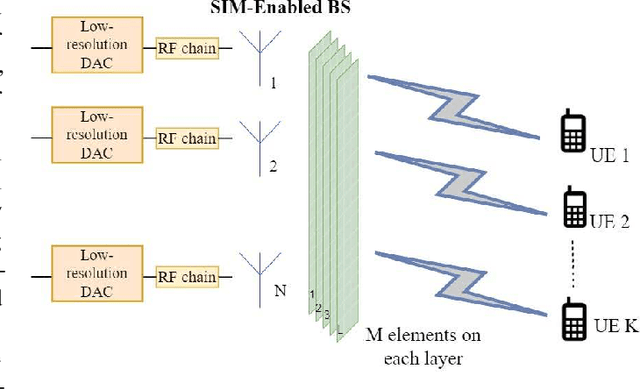
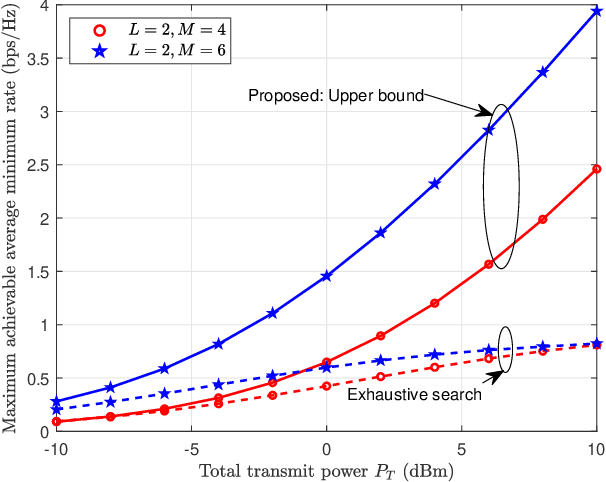
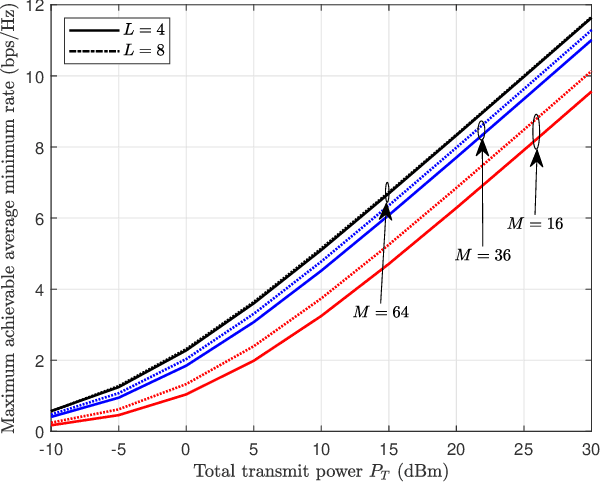
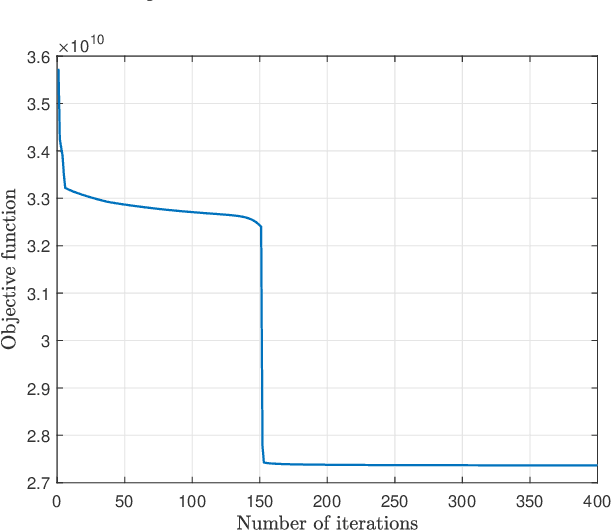
Abstract:Stacked intelligent metasurface (SIM) is an emerging technology that uses multiple reconfigurable surface layers to enable flexible wave-based beamforming. In this paper, we focus on an \ac{SIM}-assisted multi-user multiple-input single-output system, where it is essential to ensure that all users receive a fair and reliable service level. To this end, we develop two max-min fairness algorithms based on instantaneous channel state information (CSI) and statistical CSI. For the instantaneous CSI case, we propose an alternating optimization algorithm that jointly optimizes power allocation using geometric programming and wave-based beamforming coefficients using the gradient descent-ascent method. For the statistical CSI case, since deriving an exact expression for the average minimum achievable rate is analytically intractable, we derive a tight upper bound and thereby formulate a stochastic optimization problem. This problem is then solved, capitalizing on an alternating approach combining geometric programming and gradient descent algorithms, to obtain the optimal policies. Our numerical results show significant improvements in the minimum achievable rate compared to the benchmark schemes. In particular, for the instantaneous CSI scenario, the individual impact of the optimal wave-based beamforming is significantly higher than that of the power allocation strategy. Moreover, the proposed upper bound is shown to be tight in the low signal-to-noise ratio regime under the statistical CSI.
Uplink Rate Splitting Multiple Access with Imperfect Channel State Information and Interference Cancellation
Jan 31, 2025


Abstract:This article investigates the performance of uplink rate splitting multiple access (RSMA) in a two-user scenario, addressing an under-explored domain compared to its downlink counterpart. With the increasing demand for uplink communication in applications like the Internet-of-Things, it is essential to account for practical imperfections, such as inaccuracies in channel state information at the receiver (CSIR) and limitations in successive interference cancellation (SIC), to provide realistic assessments of system performance. Specifically, we derive closed-form expressions for the outage probability, throughput, and asymptotic outage behavior of uplink users, considering imperfect CSIR and SIC. We validate the accuracy of these derived expressions using Monte Carlo simulations. Our findings reveal that at low transmit power levels, imperfect CSIR significantly affects system performance more severely than SIC imperfections. However, as the transmit power increases, the impact of imperfect CSIR diminishes, while the influence of SIC imperfections becomes more pronounced. Moreover, we highlight the impact of the rate allocation factor on user performance. Finally, our comparison with non-orthogonal multiple access (NOMA) highlights the outage performance trade-offs between RSMA and NOMA. RSMA proves to be more effective in managing imperfect CSIR and enhances performance through strategic message splitting, resulting in more robust communication.
Efficient Channel Prediction for Beyond Diagonal RIS-Assisted MIMO Systems with Channel Aging
Nov 21, 2024



Abstract:Novel reconfigurable intelligent surface (RIS) architectures, known as beyond diagonal RISs (BD-RISs), have been proposed to enhance reflection efficiency and expand RIS capabilities. However, their passive nature, non-diagonal reflection matrix, and the large number of coupled reflecting elements complicate the channel state information (CSI) estimation process. The challenge further escalates in scenarios with fast-varying channels. In this paper, we address this challenge by proposing novel joint channel estimation and prediction strategies with low overhead and high accuracy for two different RIS architectures in a BD-RIS-assisted multiple-input multiple-output system under correlated fast-fading environments with channel aging. The channel estimation procedure utilizes the Tucker2 decomposition with bilinear alternative least squares, which is exploited to decompose the cascade channels of the BD-RIS-assisted system into effective channels of reduced dimension. The channel prediction framework is based on a convolutional neural network combined with an autoregressive predictor. The estimated/predicted CSI is then utilized to optimize the RIS phase shifts aiming at the maximization of the downlink sum rate. Insightful simulation results demonstrate that our proposed approach is robust to channel aging, and exhibits a high estimation accuracy. Moreover, our scheme can deliver a high average downlink sum rate, outperforming other state-of-the-art channel estimation methods. The results also reveal a remarkable reduction in pilot overhead of up to 98\% compared to baseline schemes, all imposing low computational complexity.
Probabilistic Allocation of Payload Code Rate and Header Copies in LR-FHSS Networks
Oct 07, 2024



Abstract:We evaluate the performance of the LoRaWAN Long-Range Frequency Hopping Spread Spectrum (LR-FHSS) technique using a device-level probabilistic strategy for code rate and header replica allocation. Specifically, we investigate the effects of different header replica and code rate allocations at each end-device, guided by a probability distribution provided by the network server. As a benchmark, we compare the proposed strategy with the standardized LR-FHSS data rates DR8 and DR9. Our numerical results demonstrate that the proposed strategy consistently outperforms the DR8 and DR9 standard data rates across all considered scenarios. Notably, our findings reveal that the optimal distribution rarely includes data rate DR9, while data rate DR8 significantly contributes to the goodput and energy efficiency optimizations.
Assessment of the Sparsity-Diversity Trade-offs in Active Users Detection for mMTC
Feb 08, 2024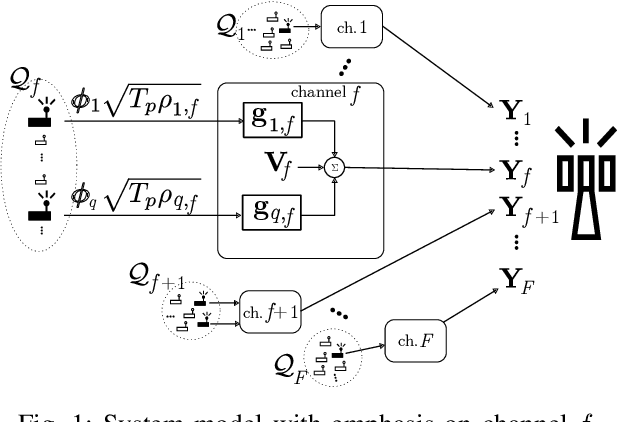
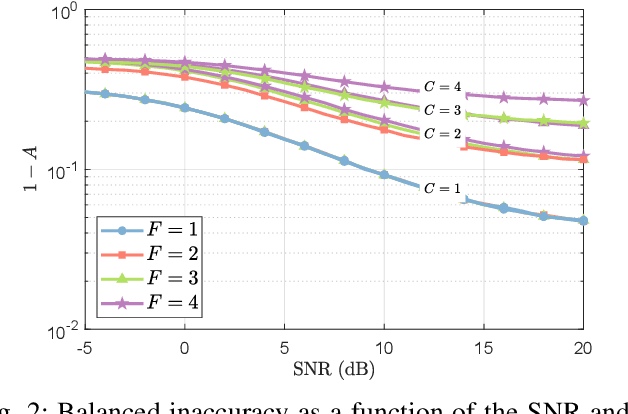
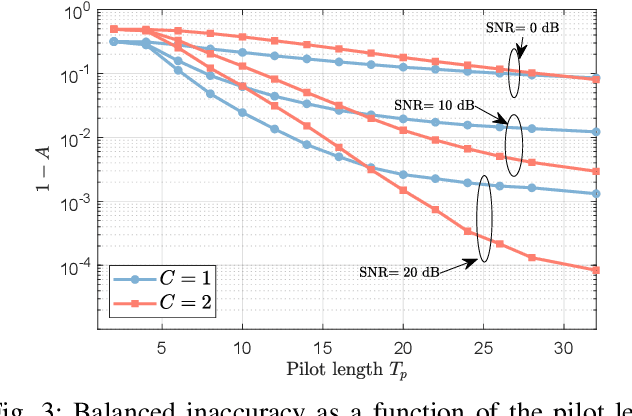
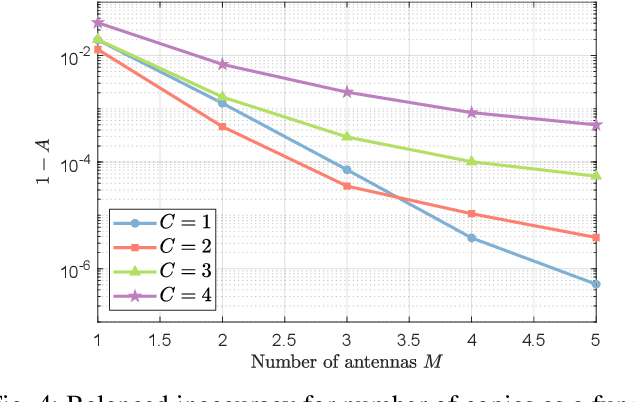
Abstract:Wireless communication systems must increasingly support a multitude of machine-type communications (MTC) devices, thus calling for advanced strategies for active user detection (AUD). Recent literature has delved into AUD techniques based on compressed sensing, highlighting the critical role of signal sparsity. This study investigates the relationship between frequency diversity and signal sparsity in the AUD problem. Single-antenna users transmit multiple copies of non-orthogonal pilots across multiple frequency channels and the base station independently performs AUD in each channel using the orthogonal matching pursuit algorithm. We note that, although frequency diversity may improve the likelihood of successful reception of the signals, it may also damage the channel sparsity level, leading to important trade-offs. We show that a sparser signal significantly benefits AUD, surpassing the advantages brought by frequency diversity in scenarios with limited temporal resources and/or high numbers of receive antennas. Conversely, with longer pilots and fewer receive antennas, investing in frequency diversity becomes more impactful, resulting in a tenfold AUD performance improvement.
Malicious RIS versus Massive MIMO: Securing Multiple Access against RIS-based Jamming Attacks
Jan 13, 2024


Abstract:In this letter, we study an attack that leverages a reconfigurable intelligent surface (RIS) to induce harmful interference toward multiple users in massive multiple-input multiple-output (mMIMO) systems during the data transmission phase. We propose an efficient and flexible weighted-sum projected gradient-based algorithm for the attacker to optimize the RIS reflection coefficients without knowing legitimate user channels. To counter such a threat, we propose two reception strategies. Simulation results demonstrate that our malicious algorithm outperforms baseline strategies while offering adaptability for targeting specific users. At the same time, our results show that our mitigation strategies are effective even if only an imperfect estimate of the cascade RIS channel is available.
Decomposition Based Interference Management Framework for Local 6G Networks
Oct 09, 2023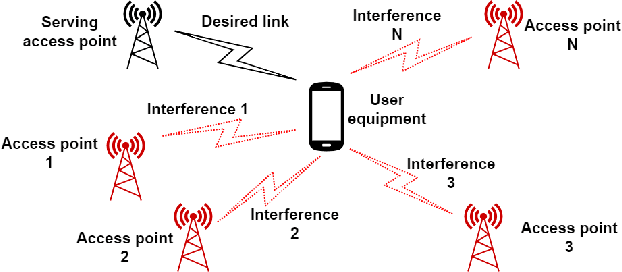
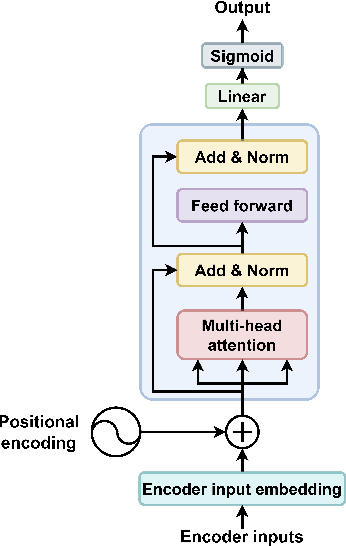

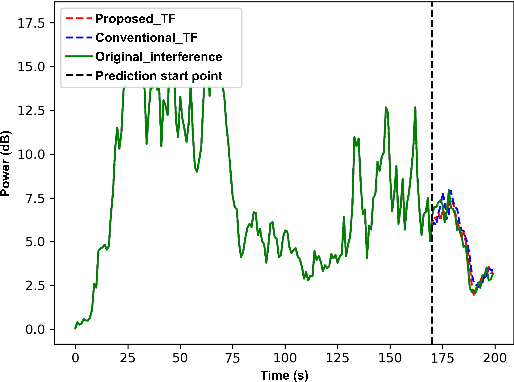
Abstract:Managing inter-cell interference is among the major challenges in a wireless network, more so when strict quality of service needs to be guaranteed such as in ultra-reliable low latency communications (URLLC) applications. This study introduces a novel intelligent interference management framework for a local 6G network that allocates resources based on interference prediction. The proposed algorithm involves an advanced signal pre-processing technique known as empirical mode decomposition followed by prediction of each decomposed component using the sequence-to-one transformer algorithm. The predicted interference power is then used to estimate future signal-to-interference plus noise ratio, and subsequently allocate resources to guarantee the high reliability required by URLLC applications. Finally, an interference cancellation scheme is explored based on the predicted interference signal with the transformer model. The proposed sequence-to-one transformer model exhibits its robustness for interference prediction. The proposed scheme is numerically evaluated against two baseline algorithms, and is found that the root mean squared error is reduced by up to 55% over a baseline scheme.
Predictive Resource Allocation for URLLC using Empirical Mode Decomposition
Apr 04, 2023



Abstract:Effective resource allocation is a crucial requirement to achieve the stringent performance targets of ultra-reliable low-latency communication (URLLC) services. Predicting future interference and utilizing it to design efficient interference management algorithms is one way to allocate resources for URLLC services effectively. This paper proposes an empirical mode decomposition (EMD) based hybrid prediction method to predict the interference and allocate resources for downlink based on the prediction results. EMD is used to decompose the past interference values faced by the user equipment. Long short-term memory and auto-regressive integrated moving average methods are used to predict the decomposed components. The final predicted interference value is reconstructed using individual predicted values of decomposed components. It is found that such a decomposition-based prediction method reduces the root mean squared error of the prediction by $20 - 25\%$. The proposed resource allocation algorithm utilizing the EMD-based interference prediction was found to meet near-optimal allocation of resources and correspondingly results in $2-3$ orders of magnitude lower outage compared to state-of-the-art baseline prediction algorithm-based resource allocation.
Multi-UAV Path Learning for Age and Power Optimization in IoT with UAV Battery Recharge
Jan 09, 2023



Abstract:In many emerging Internet of Things (IoT) applications, the freshness of the is an important design criterion. Age of Information (AoI) quantifies the freshness of the received information or status update. This work considers a setup of deployed IoT devices in an IoT network; multiple unmanned aerial vehicles (UAVs) serve as mobile relay nodes between the sensors and the base station. We formulate an optimization problem to jointly plan the UAVs' trajectory, while minimizing the AoI of the received messages and the devices' energy consumption. The solution accounts for the UAVs' battery lifetime and flight time to recharging depots to ensure the UAVs' green operation. The complex optimization problem is efficiently solved using a deep reinforcement learning algorithm. In particular, we propose a deep Q-network, which works as a function approximation to estimate the state-action value function. The proposed scheme is quick to converge and results in a lower ergodic age and ergodic energy consumption when compared with benchmark algorithms such as greedy algorithm (GA), nearest neighbour (NN), and random-walk (RW).
 Add to Chrome
Add to Chrome Add to Firefox
Add to Firefox Add to Edge
Add to Edge